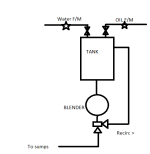Batch is where you measure the volume produced, for example:
lets assume your flow meter gives 200 pulses per gallon and you want 50 gallons then 50 x 200 = 10,000 pulses. so in batching you want 50 gallons count the pulses from the flow meter until it reaches 10,000.
Most people scale the pulses so that the actual reading is in what ever measurement you want. Flow is where you measure the actual flow in say gallons per minute, obviously you would have to convert the flow pulses into actual gallons. Matching two fluids being blended in-line the best way is to control the flow for each i.e. water 10gal/minute lube 0.1gal/minute. But as you say you have little control over the flow rate and the fact you have pulse flow meters makes flow measurement a little more difficult.
To use PID to control the flow you will need to convert the pulses to flow per minute or what ever the time base is. on such a small amount this would be a bit of a challenge but possible, however, the smaller the sample for conversion the less accuracy you will have.
The best solution I can offer is that you manually set the flow rates with manual adjusted valves so in essence water flow is say 100 gals per 10 mins and lube is 1 gal per 10 minutes, then open both control valves, count the pulses when the lube gets to 1 gal, stop the flow, when the water gets to 99 gals close that valve.
At least you will have dosed the correct amount, however, depending on the settings of the manual valves you may not get a full mix at the end, so lets assume the flow is controllable enough to allow the water to get to 95 gals and the lube to 1 gal, close the lube valve & finish off with 4 gals of water.
Using flow instead of batch there could be considerable errors as when one of the flows increases or decreases the reaction time of the PID & mechanical properties of the valve could cause considerable errors, many systems use what they call bump less start on on initial starting a pre-set value is put into the PID control to set the proportional output to a fixed amount, the idea is that rather than the PID assuming no flow it would not ramp up to full output but a level that under normal will produce the correct flow rate, after a short time the PID is put into auto control so it is closer to the normal running conditions and can quickly control around smaller fluctuations.
One other thing you must consider is how fast these pulses are and the PLC you are using, some have a small amount of inputs that will react to fast pulses and possibly I/O interrupts to catch fast pulses, most PLC's will not be able to catch pulses from flow meters as the update time of normal I/O + scan time of the program is probably slower than the pulses. What PLC are you using ? Some do have high speed functions, however, some will require the addition of a counter module and these are not cheap.
Regarding the mixer I assume if this is what is commonly called SUDS Water/oil mix then the mixer is to homogenise the two dissimilar liquids.
On a lathe for example, an operator will make up his mix manually, put it in the sump & run it round creating the mix. I think because the machines you are feeding are probably some kind of automatic process they may not want unmixed lube to pass over the work piece & cutters. I'm no expert on machining so I think it would be a good idea to find out things like mix accuracy, could it be batched etc. It does look to me if this system is on standby until one or more of the machines calls for a top up, in this case without a buffer tank then flow control is best. I think you need a bit more information.
I have not selected a PLC yet, as I am waiting to satisfactorily clear these other instrument selections. I figured once I have this, I'd go for the PLC.
Yes this will be on standby, and used on demand for different machines. You got that right. And unmixed lube cannot be added to the sump as described.





